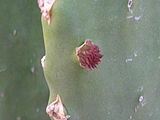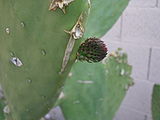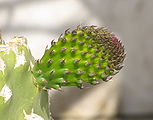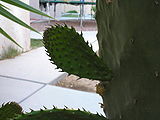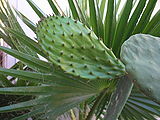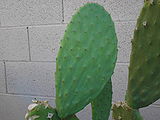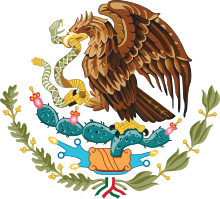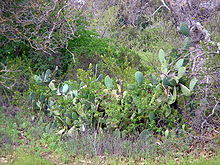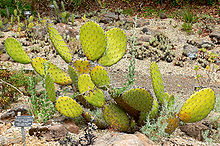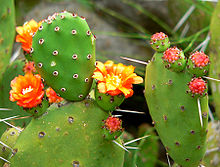- Opuntia
-
Prickly pears 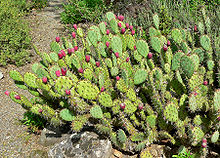
Opuntia littoralis var. vaseyi Scientific classification Kingdom: Plantae (unranked): Angiosperms (unranked): Eudicots (unranked): Core eudicots Order: Caryophyllales Family: Cactaceae Subfamily: Opuntioideae Tribe: Opuntieae Genus: Opuntia
Mill.Species Many, see text.
Synonyms - Airampoa Fric
- Cactodendron Bigelow (nom. inval.)
- Cactus Lem.
- Chaffeyopuntia Fric & Schelle
- Clavarioidia Kreuz. (nom. inval.)
- Ficindica St.-Lag.
- Nopalea Salm-Dyck
- Parviopuntia Soulaire & Marn.-Lap. (nom. inval.)
- Phyllarthus Neck. ex M.Gómez (nom. inval.)
- Pseudotephrocactus Fric
- Salmiopuntia Fric (nom. inval.)
- Subulatopuntia Fric & Schelle
- Tunas Lunell
- Weberiopuntia Fric
and see text
Opuntia, also known as nopales or paddle cactus (see below), is a genus in the cactus family, Cactaceae.
Currently, only prickly pears are included in this genus of about 200[1] species distributed throughout most of the Americas. Chollas are now separated into the genus Cylindropuntia, which some still consider a subgenus of Opuntia. Austrocylindropuntia, Corynopuntia and Micropuntia are also often included in the present genus, but like Cylindropuntia they seem rather well distinct. Brasiliopuntia and Miqueliopuntia are closer relatives of Opuntia.
The most commonly culinary species is the Indian Fig Opuntia (O. ficus-indica). Most culinary uses of the term "prickly pear" refer to this species. Prickly pears are also known as "tuna", "nopal" or nopales, from the Nahuatl word nōpalli for the pads, or nostle, from the Nahuatl word nōchtli for the fruit; or paddle cactus. This and similar species are native to Mexico.
The genus is named for the Ancient Greek city of Opus.[2]
Contents
Description
 Typical habitus of an Opuntia with fruit
Typical habitus of an Opuntia with fruit
Prickly pears typically grow with flat, rounded cladodes (also called platyclades) that are armed with two kinds of spines; large, smooth, fixed spines and small, hairlike prickles called glochids, that easily penetrate skin and detach from the plant. Many types of prickly pears grow into dense, tangled structures.
Like all true cactus species, prickly pears are native only to the Western hemisphere; however, they have been introduced to other parts of the globe. Prickly pear species are found in abundance in Mexico, especially in the central and western regions. They are also found in the Western United States, in arid regions in the Northwest, throughout the mid and lower elevations of the Rocky Mountains such as in Colorado, where species such as Opuntia phaeacantha, Opuntia polyacantha and others become dominant, and especially in the desert Southwest. Prickly pears are also the only types of cactus found to grow natively far east of the Great Plains states; O. humifusa is widespread throughout southern New England and Long Island, where it can be found in Northport, as well as throughout the northern Great Lakes states and southern Ontario, Canada. O. humifusa is also a prominent feature of the flora at Illinois Beach State Park, in Winthrop Harbor, Illinois, north of Chicago, and of Indiana Dunes State Park southeast of Chicago.
In the Galapagos Islands, there are six different species: O. echios, O. galapageia, O. helleri, O. insularis, O. saxicola, O. megasperma. These species are divided into 14 different varieties; most of these are confined to one or a few islands. For this reason, they have been described as "an excellent example of adaptive radiation".[3] On the whole, on islands where there are tall, trunked varieties there are also giant tortoises, and islands lacking tortoises have low or prostrate forms of Opuntia.
The first introduction of prickly-pear into Australia can be definitely ascribed to Governor Philip and the earliest colonists in the year 1788. Brought from Brazil to Sydney, they remained in Sydney for 50 years, until they were brought to New South Wales to a farmer's garden in 1839. The farmer's wife gave cuttings to neighbours and friends, who planted it not only in their gardens but also as hedgerows.[4] So began the Australian invasion that caused major ecological damage in the eastern states. They are also found in the Mediterranean region of Northern Africa, especially in the most northern nation of Africa, Tunisia, where they grow all over the countryside, and southern Europe, especially on the island nation of Malta, where they grow all over the islands, and can be found in enormous numbers in parts of South Africa, where it was introduced from South America.
Opuntia species are the most cold-tolerant of the lowland cacti, extending into western and southern Canada; one subspecies, Opuntia fragilis var. fragilis, has been found growing along the Beatton River in central British Columbia, southwest of Cecil Lake at 56° 17’ N latitude and 120° 39’ W longitude.[5] Prickly pears also produce a fruit that is commonly eaten in Mexico, known as tuna; it also is used to make aguas frescas. The fruit can be red, wine-red, green or yellow-orange.
Charles Darwin was the first to note that these cacti have thigmotactic anthers: when the anthers are touched, they curl over, depositing their pollen. This movement can be seen by gently poking the anthers of an open Opuntia flower. The same trait has evolved convergently in other cacti (e.g. Lophophora).
Chollas
Main article: CylindropuntiaChollas, now recognized to belong into the rather distinct genus Cylindropuntia, are distinguished by having cylindrical, rather than flattened, stem segments with the large barbed spines. The stem joints of several species, notably the jumping cholla (Cylindropuntia fulgida), are very brittle on young stems, readily breaking off when the barbed spines stick to clothing or animal bark as a method of vegetative reproduction. The barbed spines can remain embedded in the skin, causing significant discomfort and sometimes injury.
Growth (image gallery)
Bud appears ► Bud grows ► Bud grows more► Bud grows yet more► Pad continues growth ► Edible pad (tender) ► Mature pad Main producer of Opuntia
Valtierrilla in Mexico is the largest producer of Opuntia products.
The Exponopal expo, featuring a wide range of products, is held annually in February.
Uses
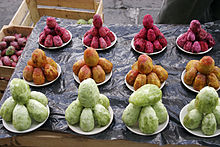 Prickly pear fruit for sale at a market, Zacatecas, Mexico
Prickly pear fruit for sale at a market, Zacatecas, Mexico
As food
The fruit of prickly pears, commonly called cactus fruit, cactus fig, Indian[6] fig or tuna in Spanish,[7] is edible, although it has to be peeled carefully to remove the small spines on the outer skin before consumption. If the outer layer is not properly removed, glochids can be ingested, causing discomfort of the throat, lips, and tongue, as the small spines are easily lodged in the skin. Native Americans, like the Tequesta, would roll the fruit around in a suitable medium (e.g. grit) to "sand" off the glochids. Alternatively, rotating the fruit in the flame of a campfire or torch has been used to remove the glochids. Today, parthenocarpic (seedless) cultivars are also available.
Cactus figs are often used to make candies, jelly, or drinks such as vodka or lemonade.[8][9][10]
Opuntia ficus-indica has been introduced to Europe, and flourishes in areas with a suitable climate, such as the south of France, southern Italy, Sicily, where they are referred to as fichi d'India or ficurinnia (Indian figs), along the Struma River in Bulgaria, in southern Portugal and Madeira, where they are called tabaibo, figo tuno or "Indian figs", and eastern and southern Spain, as well as Gibraltar where they are known as chumbo or higo chumbo ("chumbo fig"). In Greece, it grows in such places as Corfu and its figs are known as frangosyka (French figs) or pavlosyka (Paul's figs). The figs are also grown in Cyprus, where they are known as papoutsosyka or babutsa (cactus figs). The prickly pear also grows widely on the islands of Malta, where it is enjoyed by the Maltese as a typical summer fruit (known as bajtar tax-xewk, literally 'spiny figs'), as well as being used to make the popular liqueur known as bajtra. In Egypt, it is known as teen shouky. The prickly pear is so commonly found in the Maltese islands that it is often used as a dividing wall between many of Malta's characteristic terraced fields in place of the usual rubble walls. The prickly pear was introduced to Eritrea during the period of Italian colonisation between 1890 and 1940. It is locally known there as beles and is abundant during the months of late summer and early autumn (late July through September). The beles from the holy monastery of Bizen is said to be particularly sweet and juicy. In Libya, it is a popular summer fruit and called by the locals Hindi, which literally means Indian.
In Egypt, Libya, Saudi Arabia, Jordan and other parts of the Middle East, prickly pears of the yellow and orange varieties are grown by the side of farms, beside railway tracks and other otherwise noncultivable land. It is sold in summer by street vendors, and is considered a nice refreshing fruit for that season.
Tungi is the local St. Helenian name for cactus pears. The plants (Indian fig opuntia) were originally brought to the island by the colonial ivory traders from East Africa in the 1850s. Tungi cactus now grows wild and organically in the dry coastal regions of the island. Three principal cultivars of tungi grow on the island: the 'English' with yellow fruit; the 'Madeira' with large red fruit; and the small, firm 'spiny red'.
The young stem segments, usually called nopales, are also edible in most species of Opuntia. They are commonly used in Mexican cuisine in dishes such as huevos con nopales (eggs with nopal), or tacos de nopales. Nopales are also an important ingredient in New Mexican cuisine.
As medicine
Most species of Opuntia contain a range of alkaloids in ample quantities, notably substituted phenethylamines. While the mere presence of such compounds has been confirmed in many species without further details,[11] they have been studied more thoroughly in others. Identified compounds of medical significance include 3-methoxytyramine,[12] candicine,[13] hordenine,[14] N-methyltyramine,[15] and tyramine.[15] The Sicilian prickly pear contains the betalain antioxidants betanin and indicaxanthin, with highest levels in their fruits.[16]
The stem of certain Opuntia have been investigated in the treatment of type II diabetes. Although some researchers have shown a blood glucose-lowering effect of O. streptacantha,[17] another study of three other species of Opuntia (O. lasiacantha, O. velutina, and O. macrocentra) showed no such effect.[18] Yet another study, on O. megacantha, raised concern about toxic effects on the kidney.[19]
It may be that certain species are effective and useful in diabetes while others are not, but this needs to be clarified with further research before recommending its use. Furthermore, when buying nopal in the market, it is impossible to know which species one is buying, and therefore whether or not it is useful in treating diabetes.
Indian Fig Opuntia (and probably others) might have a reducing effect on alcohol hangover by inhibiting the production of inflammatory mediators. Studies have yielded differing results, with some studies witnessing significant reductions in nausea, dry mouth, and loss of appetite as well as less risk of a severe hangover,[20] while others witnessing no compelling evidence for effects on alcohol hangover.[21]
The gel-like sap of prickly pears can be used as hair conditioner.[22]
In Mexico and the Southwest, its pulp and juice have been used to treat numerous maladies, such as wounds and inflammations of the digestive and urinary tracts.[23]
As an intoxicant
Mexicans have used the fruit for hundreds of years, natives for thousands, to make colonche, an alcoholic drink. At least two commercially important distilled spirits are produced from Opuntia fruit. In Malta, the pink herbal bajtra liqueur is made from Opuntia.[24] A St. Helenian distillery produces the clear, more potent Tungi Spirit from Indian fig opuntia cv. 'English' and 'Madeira'.
Opuntia is also added sometimes to the entheogenic drink Ayahuasca.[25] Psychoactive compounds and derivates thereof have been confirmed in some species. These include 3,4-DMPEA,[26] 4-hydroxy-3,5-DMPEA,[27] and mescaline.[28]
In dye production
Main article: Cochineal Traditional "Zapotec nest" farming of the cochineal scale insect on O. ficus-indica, Oaxaca
Traditional "Zapotec nest" farming of the cochineal scale insect on O. ficus-indica, Oaxaca
Dactylopius coccus is a scale insect, from which the cochineal dye is derived. D. coccus itself is native to tropical and subtropical South America and Mexico. This type of insect, a primarily sessile parasite, lives on cacti from the genus Opuntia, feeding on moisture and nutrients in the cactus sap. The insect produces carminic acid, which deters predation by other insects. The carminic acid can be extracted from the insect's body and eggs to make the red dye.
Cochineal is primarily used as a red food colouring and for cosmetics. The cochineal dye was used by the Aztec and Maya peoples of Central and North America. Produced almost exclusively in Oaxaca, Mexico by indigenous producers, cochineal became Mexico's second most valued export after silver.[29] The dyestuff was consumed throughout Europe, and was so highly valued that its price was regularly quoted on the London and Amsterdam Commodity Exchanges.
Now, the highest production of cochineal is by Peru, the Canary Islands and Chile. Current health concerns over artificial food additives have renewed the popularity of cochineal dyes, and the increased demand is making cultivation of the insect an attractive opportunity in other regions, such as in Mexico, where cochineal production had declined again due to the scale insect having numerous natural enemies.[30]
Apart from cochineal, the red dye betanin can be extracted from some Opuntia plants themselves.
For earthen walls
Fluid ("cactus juice") extracted from Opuntia pads and stems, especially O. ficus-indica, is one of the most commonly used additives in earthen plaster.
The juice from the prickly pear cactus leaf pads will serve many functions. According to some sources, it helps the plaster set and increases its stickiness or adhesion. Cactus juice also serves as a stabilizer in that it helps make earthen plasters more water resistant and more durable. It also prevents dusting.
Cactus juice can increase plaster's workability and its ability to be formed into the desired shape. Workability depends on the water content, the shape and size distribution of its aggregate (aggregate can be rock, sand, natural fiber, etc.), the age of the plaster, and the amount of other natural binder(s) (natural binders are clay, lime, wheatpaste, cactus juice, etc.) Altering the water content, changing the aggregate mix, the age of the plaster, or changing the binders will increase or decrease the plaster's workability. Excessive water will lead to increased bleeding (surface water) and/or segregation of aggregates (when the natural binder and aggregates start to separate), with the resulting plaster having reduced quality. The use of an aggregate with an undesirable gradation can result in a very harsh mix design with a very low workability, which cannot be readily made more workable by addition of reasonable amounts of water or binder.
Cactus juice works well because it contains pectin, a water soluble long-chain carbohydrate that acts as the binding agent to increase the adhesion of an earthen plaster. Pectin is also responsible for increasing the water resistance of an earthen plaster and has been used to augment lime plasters in both Mexico and the southwestern United States for hundreds of years.
Cactus juice is extracted by immersing cut leaves in water for as long as two weeks.[31]
In culture
See also: Coat of arms of MexicoThe coat of arms of Mexico depicts a Mexican golden eagle, perched upon an Opuntia cactus, devouring a rattlesnake. According to the official history of Mexico, the coat of arms is inspired by an Aztec legend regarding the founding of Tenochtitlan. The Aztecs, then a nomadic tribe, were wandering throughout Mexico in search of a divine sign that would indicate the precise spot upon which they were to build their capital. Their god Huitzilopochtli had commanded them to find an eagle devouring a snake, perched atop a cactus that grew on a rock submerged in a lake. After two hundred years of wandering, they found the promised sign on a small island in the swampy Lake Texcoco. It was there they founded their new capital, Tenochtitlan. The cactus (Opuntia ficus-indica; Nahuatl: tenochtli), full of fruits, is the symbol for the island of Tenochtitlan.
The 1975–1988 version of the coat of arms of Malta also featured an opuntia.
In Israel, the cactus fig is called tzabar (Hebrew: צבר) similar to and derived from the Arabic 'saber'. This is also the origin of the term sabra used to describe for Jew born in Israel.[32] The prickly pear cactus has been used for centuries both as a food source and a natural fence that keeps in livestock and marks the boundaries of family lands. They are incredibly resilient and often grow back. The cactus is called 'saber' in Arabic, which also means 'tenacity'.[33]
The cactus lends its name to a song by British jazz/classical group Portico Quartet. The song "My Rival", on the album Gaucho by the American jazz-pop group Steely Dan begins with the words, "The wind was driving in my face/The smell of prickly pear."[34]
In the fall of 1961, Cuba had its troops plant an 8-mile (13 km) barrier of Opuntia cactus along the northeastern section of the 28-kilometre (17 mi) fence surrounding the Guantanamo Bay Naval Base to stop Cubans from escaping Cuba to take refuge in the United States.[35] This was dubbed the "Cactus Curtain", an allusion to Europe's Iron Curtain[36] and the Bamboo Curtain in East Asia.
Ecology
Opuntia spreads into large clonal colonies, which contributes to its being considered a noxious weed in some places.[37]
Prickly pears (mostly Opuntia stricta) were originally imported into Australia in the 18th century for gardens, and were later used as a natural agricultural fencing[4] and in an attempt to establish a cochineal dye industry. They quickly became a widespread invasive weed, eventually converting 101,000 sq mi (260,000 km2) of farming land into an impenetrable green jungle of prickly-pear, in places 20 ft (6.1 m) high. Scores of farmers were driven off their land by what they called the “green hell”; their abandoned homes were crushed under the cactus growth which advanced at a rate of 1,000,000 acres (4,046.9 km2; 1,562.5 sq mi) per year.[4] In 1919, the Federal Government established the Commonwealth Prickly Pear Board to coordinate efforts to eradicate them with the State Governments. Early attempts with mechanical removal and poisonous chemicals failed, so in a last resort, biological control was attempted.[4] The moth Cactoblastis cactorum from South America, the larvae of which eat prickly pear, was introduced in 1925 and almost wiped out the cactus population. The son of the noted entomologist Frederick Parkhurst Dodd, Alan Dodd was a lead official in combating the prickly pear. There is a memorial hall in Chinchilla Australia commemorating the moth.[4]
The same moth, introduced accidentally further north of its native range into southern North America, is causing serious damage to some native species in that area.
Other animals that eat Opuntia include the prickly pear island snail and Cyclura rock iguanas. The fruit are relished by many aridland animals, chiefly birds, which thus help distribute the seeds. Opuntia pathogens include the sac fungus Colletotrichum coccodes and Sammons' Opuntia virus. The ant Crematogaster opuntiae and the spider Theridion opuntia are named for their association with prickly pear cacti.
Selected species
Opuntia hybridizes readily between species.[37] This can make classification difficult. Also, not all species listed here may actually belong into this genus.
 Pinkava's Prickly Pear (Opuntia pinkavae), named in honor of Donald John Pinkava
Pinkava's Prickly Pear (Opuntia pinkavae), named in honor of Donald John Pinkava
 Opuntia robusta flowers
Opuntia robusta flowers
- Opuntia aciculata – Chenille Prickly Pear , Old Man's Whiskers, Cowboy’s Red Whiskers
- Opuntia anacantha
- Opuntia atrispina
- Opuntia auberi
- Opuntia aurantiaca
- Opuntia basilaris – Beavertail cactus
- Opuntia boldinghii
- Opuntia chaffeyi
- Opuntia chlorotica – Pancake Prickly Pear; native to southwest USA and the Sonoran and Mojave deserts.
- Opuntia clavata
- Opuntia cochenillifera
- Opuntia comonduensis
- Opuntia compressa
- Opuntia curvospina
- Opuntia decumana
- Opuntia decumbens – Nopal de Culebra
- Opuntia dejecta
- Opuntia echinocarpa
- Opuntia echios
- Opuntia echios var. gigantea – Galápagos prickly pear. Galápagos Islands.
- Opuntia elata
- Opuntia elatior Mill. – syn. O. bergeriana
- Opuntia engelmannii – Engelmann's Prickly Pear, Cow's-tongue Prickly Pear, Desert Prickly Pear, Discus Prickly Pear, Texas Prickly Pear, calico cactus
- Opuntia erinacea
- Opuntia exaltata
- Opuntia excelsa
- Opuntia ficus-barbarica
- Opuntia ficus-indica – Indian Fig Opuntia
- Opuntia fragilis – Little Prickly Pear, brittle cactus. Found in the Great Plains and as far west as British Columbia.
- Opuntia galapageia
- Opuntia gosseliniana – Violet Prickly Pear
- Opuntia gosseliniana var. santa-rita – Santa Rita Prickly Pear
- Opuntia helleri
- Opuntia hickenii
- Opuntia humifusa – Eastern Prickly Pear (sometimes included in O. compressa)
- Opuntia hyptiacantha
- Opuntia inamoema K. Schum. – quipá
- Opuntia insularis
- Opuntia invicta
- Opuntia jamaicensis
- Opuntia laevis
- Opuntia lasiacantha
- Opuntia leucotricha – Arborescent Prickly Pear, Aaron's beard cactus, semaphore cactus, Duraznillo blanco, Nopal blanco
- Opuntia lindheimeri – Cowtongue Prickly Pear
- Opuntia littoralis – Sprawling Prickly Pear
- Opuntia longispina
- Opuntia macrocentra – Black-spine Prickly Pear, Purple Prickly Pear. Found in southwest USA and northern Mexico.
- Opuntia macrorhiza – Plains Prickly Pear. Found throughout the Great Plains except for the northernmost areas (not found in North Dakota), and extending sporadically eastward as far as Kentucky. Syn. O. leptocarpa MacKensen, O. tenuispina Engelm., O. tortispina Engelm. & Bigelow
- Opuntia matudae – xoconostle (syn. Opuntia joconostle)
- Opuntia maldonandensis
- Opuntia maxima
- Opuntia megacantha
- Opuntia megarrhiza
- Opuntia megasperma
- Opuntia microdasys – Bunny ears cactus, Polka-dot cactus
- Opuntia monacantha – Common Prickly Pear
- Opuntia oricola
- Opuntia ovata
- Opuntia paraguayensis
- Opuntia phaeacantha – Tulip Prickly Pear. Includes Plateau Prickly Pear, Brown-spined Prickly Pear, Mojave Prickly Pear, Kingman Prickly Pear.
- Opuntia pinkavae – Pinkava's Prickly Pear
- Opuntia polyacantha – Panhandle Prickly Pear. Found in the Great Plains, Great Basin, Mojave Desert, Colorado Plateau, and the Rocky Mountains. Syn. O. rhodantha K.Schum.
- Opuntia polyacantha var. arenaria (syn. O. erinacea)
- Opuntia pubescens (syn. O. pascoensis Britton & Rose)
- Opuntia pusilla – Creeping cactus. Syn. O. drummondii Graham
- Opuntia quitensis – Red Buttons Opuntia (syn. O. macbridei, O. johnsonii, Platyopuntia quitensis)
- Opuntia rastrera
- Opuntia repens
- Opuntia robusta
- Opuntia rufida (sometimes included in O. microdasys)
- Opuntia saxicola
- Opuntia schumannii
- Opuntia soehrensii
- Opuntia stenopetala (syn. O. riviereana Backeb.)
- Opuntia streptacantha
- Opuntia stricta – Erect Prickly Pear, Spineless Prickly Pear, Coastal Prickly Pear
- Opuntia subulata – found in South America
- Opuntia sulphurea
- Opuntia taylori
- Opuntia tehuantepecana – Nopal de Caballo
- Opuntia tomentosa – Woollyjoint Prickly Pear
- Opuntia triacantha
- Opuntia tuna
- Opuntia velutina
- Opuntia violacea
Formerly in Opuntia
- Austrocylindropuntia
- Brasiliopuntia
- Corynopuntia
- Cylindropuntia
- Disocactus phyllanthoides (as Opuntia speciosa)
- Micropuntia
- Miqueliopuntia
See also
- Prickly pears in Australia
Footnotes
- ^ Rebman, Jon P.. "What has happened to Opuntia?". San Diego Natural History Museum. http://www.sdnhm.org/research/botany/opuntioideae.html.
- ^ Quattrocchi, Umberto (2000). CRC World Dictionary of Plant Names. III M-Q. CRC Press. p. 1885. ISBN 9780849326776. http://books.google.com/?id=kaN-hLL-3qEC.
- ^ Fitter, Fitter, and Hosking, Wildlife of the Galapagos (2000)
- ^ a b c d e Patterson, Ewen K. 1936. The World's First Insect Memorial. “The Review of the River Plate”, December pp.16-17
- ^ Cota-Sánchez (2002)
- ^ Originally meaning "Native American", though the specific epithet, "ficus-indica", means "fig from India". Note also Ficus benghalensis which is both a true fig tree and from South Asia.
- ^ Grigson, Jane. Jane Grigson's Fruit Book, 2007, U of Nebraska Press, p. 380. ISBN 080325993X
- ^ Midey, Connie (May 31, 2005). "A magical plant". The Arizona Republic. http://www.azcentral.com/health/diet/articles/0531prickly0531.html. Retrieved May 22, 2010.
- ^ Jarman, Max (October 11, 2005). "Hand crafted hooch: Prickly pear vodka from Flagstaff". The Arizona Republic. http://www.azcentral.com/ent/music/articles/1012distillery-ON-CP.html. Retrieved May 22, 2010.
- ^ Gist, Wendy (May 2009). "Southwest Flavor: Stick to It". New Mexico Magazine. http://www.nmmagazine.com/swflavor_pricklypear_may09.php. Retrieved May 22, 2010.
- ^ Opuntia chlorotica, O. cochinellifera, O. comonduensis, O. compressa, O. curvospina, O. decumana, O. elatior, O. ficus-barbarica, O. fragilis, O. humifusa, O. hyptiacantha, O. lindheimeri, O. littoralis, O. maxima, O. megacantha, O. microdasys, O. pachypus, O. phaeacantha, O. polyacantha, O. retrosa, O. soehrensii, O. streptacantha, O. stricta, O. violacea: Trenary (1997)
- ^ Confirmed in Opuntia subulata: Trenary (1997)
- ^ Confirmed in Opuntia hickenii: Trenary (1997)
- ^ Confirmed in Opuntia aurantiaca (.014%), O. clavata, O. ficus-indica (.01%), O. maldonandensis (.01%): Trenary (1997)
- ^ a b Confirmed in Opuntia clavata, O. ficus-indica, O. invicta: Trenary (1997)
- ^ Butera, Daniela; Luisa Tesoriere, Francesca Di Gaudio, Antonino Bongiorno, Mario Allegra, Anna Maria Pintaudi, Rohn Kohen, and Maria A. Livrea (2002). "Antioxidant activities of sicilian prickly pear (Opuntia ficus indica) fruit extracts and reducing properties of its betalains: betanin and indicaxanthin". Journal of Agricultural Food Chemistry 50 (23): 6895–6901. doi:10.1021/jf025696p. PMID 12405794.
- ^ Frati-Munari et al. (1983)
- ^ Keith et al. (1998)
- ^ Bwititi et al. (2000)
- ^ Wiese et al. (2004)
- ^ Pittler et al. (2005)
- ^ Nyerges, Christopher. "Prickly Pear Cactus". Wilderness Way 6 (2). http://www.wwmag.net/pricklycactus.htm.
- ^ Frati AC, Xilotl Diaz N, Altamirano P, Ariza R, Lopez-Ledesma R."The effect of two sequential doses of Opuntia streptacantha upon glycemia"(1991)
- ^ Bajtra (Bajtra Liqueur official site)
- ^ Ott (1995)
- ^ Confirmed in Opuntia exaltata: Trenary (1997)
- ^ Confirmed in Opuntia basilaris, O. exaltata: Trenary (1997)
- ^ Confirmed in Opuntia basilaris (.01%), O. ficus-indica, O. invicta: Trenary (1997)
- ^ Behan (1995)
- ^ Portillo M. & Vigueras G. (1988)
- ^ Guelberth, Cedar Rose; Dan Chiras (2003). The Natural Plaster Book. New Society Publishers.
- ^ Over here and over there. The Economist, 2006-NOV-16. Retrieved 2007-OCT-16.
- ^ Tamir, Tally (1999). "The Shadow of Foreignness: On the Paintings of Asim Abu-Shakra". Palestine-Israel Journal 6 (1). http://www.pij.org/details.php?id=962.
- ^ "LYRICS | GAUCHO (1980)". Steely Dan. http://steelydan.com/lyrgaucho.html#track6.
- ^ "Guantanamo Bay Naval Base and Ecological Crises". Trade and Environment Database. American University. http://www1.american.edu/TED/guantan.htm. Retrieved 2009-04-19.
- ^ "Yankees Besieged". TIME. 1962-03-16. http://www.time.com/time/magazine/article/0,9171,940656,00.html.
- ^ a b Griffith, M. P. 2004. The origins of an important cactus crop, Opuntia ficus-indica (Cactaceae): New molecular evidence. American Journal of Botany 91: 1915–1921.
References
- Behan, Jeff (1995): The bug that changed history. Boatman's Quarterly Rreview 8(2). HTML fulltext
- Bwititi, P.; Musabayane, C.T. & Nhachi, C.F.B. (2000): Effects of Opuntia megacantha on blood glucose and kidney function in streptozotocin diabetic rats. Journal of Ethnopharmacology 69(3): 247–252. doi:10.1016/S0378-8741(99)00123-3 PMID 10722207 (HTML abstract)
- Cota-Sánchez, J. Hugo (2002): Taxonomy, distribution, rarity status and uses of Canadian Cacti. Haseltonia 9: 17–25 Google Scholar PDF abstract
- Frati-Munari, A.C.; Fernandez-Harp, J.A.; de la Riva, H.; Ariza-Andraca, R. & del Carmen Torres, M. (1983): Effects of nopal (Opuntia sp.) on serum lipids, glycemia and body weight. Archivos de investigacion medica 14(2): 117–125. PMID 6314922 [Article in English, Spanish]
- Ott, Jonathan (1995): In: Ayahuasca Analogues: Pangaean Entheogens.
- Pittler, Max H.; Verster, Joris C. & Ernst, Edzard (2005): Interventions for preventing or treating alcohol hangover: systematic review of randomised controlled trials. Brit. Med. J. 331(7531): 1515–1518. doi:10.1136/bmj.331.7531.1515 PMID 16373736 PDF fulltext
- Portillo M., Liberato & Vigueras G., Ana Lilia (1988): Natural Enemies of Cochineal (Dactylopius coccus Costa): Importance in Mexico. Journal of the Professional Association for Cactus Development 3: 43–49. PDF fulltext
- Rayburn, Keith M.D.; Martinez, Rey; Escobedo, Miguel; Wright, Fred & Farias, Maria (1998): Glycemic Effects of Various Species of Nopal (Opuntia sp.) in Type 2 Diabetes Mellitus. Texas Journal of Rural Health 16(1): 68–76.
- Trenary, Klaus (1997): Visionary Cactus Guide: Opunita [sic]. Retrieved 2007-OCT-15.
- Wiese, Jeff; McPherson, Steve; Odden, Michelle C. & Shlipak, Michael G. (2004): Effect of Opuntia ficus indica [sic] on Symptoms of the Alcohol Hangover. Arch. Intern. Med. 164(12): 1334–1340. PDF fulltext
External links
Categories:- Opuntia
- Cacti of the United States
- Cacti of Mexico
- Cacti of South America
- Flora of South America
- Flora of Central America
- Flora of North America
- Invasive plant species
- Invasive plant species in South Africa
- North American desert flora
- Native American cuisine
- Mesoamerican cuisine
- Ayahuasca
- Desert fruit
- Medicinal plants
- Mexican cuisine
- Mexican ingredients
- Mexican liquor
- Mexican alcoholic beverages
- Nahuatl words and phrases
Wikimedia Foundation. 2010.

